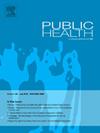Diabetes incidence before and after the pandemic onset in adult subgroups with prediabetes
IF 3.2
3区 医学
Q1 PUBLIC, ENVIRONMENTAL & OCCUPATIONAL HEALTH
引用次数: 0
Abstract
Objectives
During the COVID-19 pandemic, type 2 diabetes (T2D) incidence increased, but it remains unclear if different groups were disproportionately affected. We evaluated overall changes in T2D incidence before and during the pandemic and by insurance type, sex, and race/ethnicity subgroups.
Study design
Retrospective dynamic cohort.
Methods
We included 323,609 adults (≥18–89 years) with prediabetes and BMI ≥25 kg/m2 (or ≥23 if Asian) using electronic health record data from Kaiser Permanente Northern California (2019–2021). T2D was defined comprehensively with diagnosis codes, glycemic tests and/or filled diabetes medications. In secondary analyses, T2D was defined by the first diabetes-range lab test among screened adults. Sensitivity analyses addressed screening bias using inverse probability weighting and propensity scores. An interrupted time-series analysis assessed T2D incidence changes following the pandemic onset (March 2020).
Results
Before the pandemic, monthly T2D incidence was stable. After the pandemic onset, the monthly trend increased by 6.5 % (−0.2 %, 10.3 %) for comprehensive and 3.2 % (0.6 %, 5.1 %) for lab-only; both trends persisted through 2021. After accounting for differential screening bias this increase remained but was not significant given wider confidence intervals. T2D incidence level for lab-only increased 51 % more among Hispanic vs. White adults and persisted through 2021. No other group differences were observed.
Conclusions
The pandemic onset was followed by an increase in T2D incidence overall and with sharper increases among Hispanic adults. This highlights the broader health changes of the pandemic and underscores the need for public health strategies to manage this growing burden.
糖尿病前期成人亚群在大流行发病前后的糖尿病发病率。
目的:在2019冠状病毒病大流行期间,2型糖尿病(T2D)发病率增加,但尚不清楚不同人群是否不成比例地受到影响。我们评估了大流行前和大流行期间T2D发病率的总体变化,并按保险类型、性别和种族/民族亚组进行了评估。研究设计:回顾性动态队列。方法:我们纳入了323,609名糖尿病前期成年人(≥18-89岁),BMI≥25 kg/m2(亚洲人≥23),使用来自北加州凯撒医疗机构(2019-2021)的电子健康记录数据。通过诊断代码、血糖测试和/或填充糖尿病药物全面定义T2D。在二次分析中,T2D是通过筛查成人的第一次糖尿病范围实验室测试来定义的。敏感性分析使用逆概率加权和倾向得分来解决筛选偏差。中断时间序列分析评估了大流行爆发(2020年3月)后T2D发病率的变化。结果:大流行前,T2D月发病率基本稳定。大流行发生后,综合的月趋势增加6.5%(- 0.2%,10.3%),实验室的月趋势增加3.2% (0.6%,5.1%);这两种趋势一直持续到2021年。在考虑了差异筛选偏差后,这种增加仍然存在,但在更宽的置信区间内并不显著。西班牙裔成年人的T2D发病率比白人高51%,并持续到2021年。未观察到其他组间差异。结论:大流行发生后,T2D发病率总体上升,西班牙裔成年人的上升幅度更大。这凸显了大流行对健康造成的更广泛变化,并强调需要制定公共卫生战略来管理这一日益加重的负担。
本文章由计算机程序翻译,如有差异,请以英文原文为准。
求助全文
约1分钟内获得全文
求助全文
来源期刊

Public Health
医学-公共卫生、环境卫生与职业卫生
CiteScore
7.60
自引率
0.00%
发文量
280
审稿时长
37 days
期刊介绍:
Public Health is an international, multidisciplinary peer-reviewed journal. It publishes original papers, reviews and short reports on all aspects of the science, philosophy, and practice of public health.
 求助内容:
求助内容: 应助结果提醒方式:
应助结果提醒方式:


